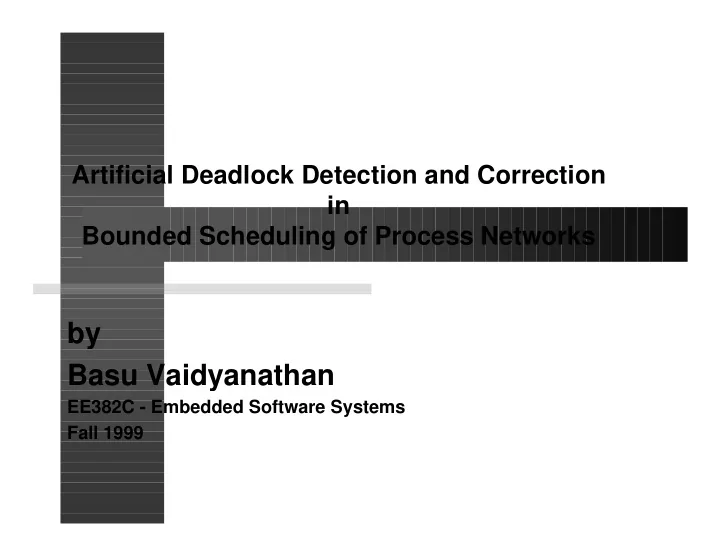

Artificial Deadlock Detection and Correction in Bounded Scheduling of Process Networks by Basu Vaidyanathan EE382C - Embedded Software Systems Fall 1999
Goals � Understand the bounded scheduling of process networks � Develop an algorithm and implement to detect the artificial deadlock and to resolve it to continue the program � Understand the existing basic PN framework implementation � Modify the code to keep it modular and transparent to applications
Process Networks � A networked set of Turing machines � Models functional parallelism and simulation possible on SMP hardware � Well-suited for signal processing systems that deal with infinite streams of data � Termination and Boundedness are undecidable.
Process Networks � Kahn process networks model: – has finite set of processes and FIFO queues – execution of a process suspended on read from an empty queue – a process cannot wait for data from one queue or another – a process may not test for presence or absence of data – Systems that follow Kahn’s model are determinate
Process Networks � Karp and Miller Computation Graph: – requires a threshold number of tokens on the arc before the consumer can fire � Number of tokens produced/consumed is known only at runtime � Dynamic scheduling is needed. It requires: – 1. Non-terminating programs must execute forever – 2. If possible, tokens accumulation on any of the FIFO queues must be bounded
Process Networks � Parks Scheduling policy has three rules: – 1. Process suspended when reading an empty queue – 2. Process suspended when writing to a full queue – 3. On artificial deadlock, increase the smallest full queue size until a producer can fire. � Realizes program execution forever with bounded memory whenever possible.
Process Networks � Artificial Deadlock – Occurs when atleast one process is suspended on write to a full queue � True Deadlock – If all the processes are suspended on read then the program has terminated
Basic Process Networks Framework � Implementation details: – Developed by Greg Allen of ARL at UT – Implemented in C++, combined with POSIX Pthread library for portability – Threshold and PNThreshold queue layers – Each node as a pthread – FIFO queues have input and output firing thresholds – Threshold amount of queue data mirrored to provide address/data continuity
Basic Process Networks Framework – Node computation time greater than thread context switch time – POSIX condition variable used to awaken consumer once data is available and to awaken producer once space is available – Applied in Sonar Beamforming, a real-time problem where deadlock detection is not needed – provides a programming model for applications
My Design and Implementation � Details: – Variable queue size for each FIFO queue – Maintain a list of qEntry class sorted by queue size. qEntry has Queue id, iswriteblocked stored in shared memory – Last thread in the network before suspending itself awakens all threads suspended on write – Only the thread with smallest queue size expands its queue size and continues and rest of the awakened threads suspended again. – Never gets into artificial deadlock situation – deadlock detection handled in PN queue layer
Issues and Improvements � When expanding the queue reallocation of queue buffer is not possible � Our PN implementation must not introduce additional deadlock violating locking hierarchy � Use of a dedicated thread to handle deadlock � Last thread can avoid awakening all threads suspended on write � Searching qEntry list can be improved
Any Questions?
Recommend
More recommend